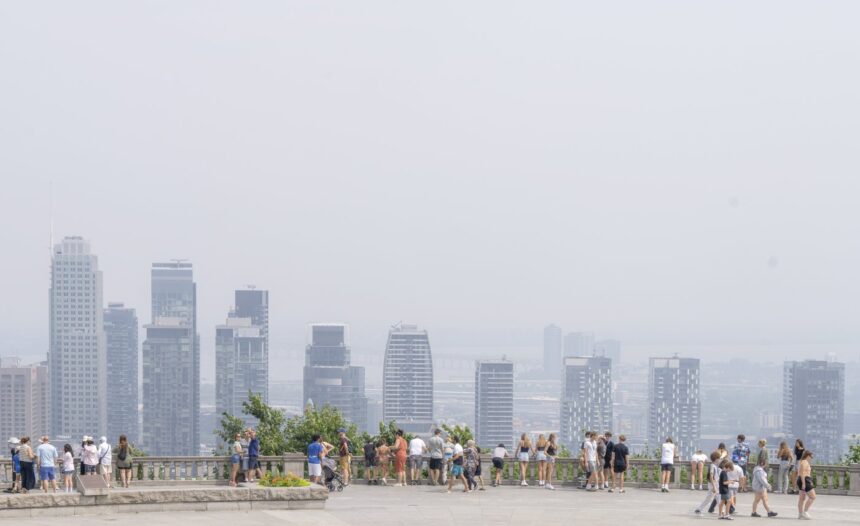I stepped out of the car in Rouyn-Noranda last August, and my lungs immediately protested. The air felt thick, almost syrupy, as I made my way to meet Dr. Claudel Pétrin-Desrosiers at a local café. Through the haze, the outline of the Horne Smelter—a copper processing facility that has operated in this northern Quebec town since 1927—loomed as both economic lifeline and health concern.
“People here talk about ‘smelter lung’ like it’s just another fact of life,” Dr. Pétrin-Desrosiers told me, stirring her tea. As chair of the Quebec Association of Physicians for the Environment (QAPE), she’s been tracking a troubling pattern across the province. “But what we’re seeing now goes beyond industrial zones. Climate change is creating conditions where air pollution affects everyone.”
New warnings from Quebec’s medical community suggest that repeated exposure to smog—even at levels once considered merely unpleasant rather than dangerous—may cause lasting damage to respiratory and cardiovascular systems. This represents a significant shift in how doctors understand air pollution’s effects.
“We used to think of smog as a temporary irritant,” explained Dr. Pétrin-Desrosiers. “Now we understand these episodes have cumulative effects. Each exposure potentially leaves a mark on the body.”
The Canadian Medical Association Journal published research last year estimating that air pollution contributes to approximately 15,300 premature deaths annually in Canada. In Quebec alone, the provincial public health institute attributes about 4,000 deaths per year to poor air quality.
Dr. Marianne Hatzopoulou, who leads the Transportation and Air Quality Research Group at the University of Toronto, has spent years studying urban pollution patterns. When I called her about Quebec’s situation, she emphasized that air quality challenges are increasing nationwide.
“What makes Quebec’s situation particularly concerning is the combination of industrial emissions, transportation pollution in urban centers, and now the wildfire smoke that’s becoming more frequent with climate change,” she explained. “The body doesn’t distinguish between sources when processing these pollutants.”
The health effects range from the immediately apparent—burning eyes, scratchy throats, and difficulty breathing—to the invisible and cumulative. Long-term exposure has been linked to increased rates of asthma, chronic obstructive pulmonary disease, heart attacks, strokes, and even some cancers, according to Health Canada’s air quality assessment reports.
I met Marie-Claude Beaulieu at her Laval home, where air purifiers hummed in every room. At 67, she’s developed what her doctors describe as “pollution-induced asthma” after decades of living near Montreal’s highways.
“Ten years ago, I could garden all day,” she said, gesturing toward her now-neglected flower beds visible through the window. “Now, on smog days, even walking to get the mail can leave me gasping.” She keeps three different inhalers on her kitchen counter, labeled for different severity levels.
Environment and Climate Change Canada has recorded a troubling increase in air quality advisories across Quebec over the past five years. Last summer saw a record 42 days of smog warnings in Montreal alone, nearly double the historical average.
Dr. Louis-Philippe Boulet of the Quebec Lung Association points to a perfect storm of factors. “We’re seeing climate change extending our smog season. Higher temperatures accelerate the formation of ground-level ozone, one of smog’s main components,” he told me during a phone interview.
The situation becomes more complex in Quebec’s northern communities. In Abitibi-Témiscamingue, industrial emissions combine with increasingly frequent wildfire smoke. Last summer, residents of Val-d’Or lived under an eerie orange sky for nearly two weeks as fires burned across the northern boreal forest.
Public health officials are particularly concerned about vulnerable populations: children, whose developing lungs can be permanently affected by air pollution; the elderly; and those with pre-existing conditions. But new research suggests even healthy adults face risks with repeated exposure.
Dr. Caroline Duchaine, an air quality researcher at Université Laval, explained that microscopic particulate matter—especially PM2.5, particles smaller than 2.5 micrometers—can enter the bloodstream through the lungs and potentially affect every organ system.
“These particles don’t just irritate the respiratory tract,” she said. “They trigger inflammatory responses throughout the body. We’re finding connections to cognitive decline, pregnancy complications, and metabolic disorders that weren’t previously recognized.”
The Quebec government has responded by expanding its air quality monitoring network and issuing more frequent advisories, but physicians’ groups argue these measures don’t address the root causes. They’re calling for stricter industrial emission controls, accelerated transition to electric vehicles, and better urban planning to reduce pollution sources.
Back in Rouyn-Noranda, I watched children playing soccer in the town park despite the visible haze. Their coach, Michel Thériault, shrugged when I asked if he considered canceling practice.
“If we stopped for air quality, they might never play in summer anymore,” he said, though he admitted to keeping practices shorter on the worst days.
This resignation was something I encountered repeatedly—a sense that diminished air quality has become the new normal. But medical experts stress that acceptance is dangerous, especially as evidence mounts about long-term health impacts.
“We can’t adapt our lungs to pollution,” Dr. Pétrin-Desrosiers emphasized before we parted. “The human respiratory system evolved over millions of years in clean air. There’s no physiological adaptation possible in a single generation.”
As I drove back toward Montreal the next day, emergency alerts pinged on my phone warning of another smog event developing. Through my windshield, the approaching city was already disappearing behind a yellowish haze, as invisible health consequences continued to accumulate in the lungs of millions.






